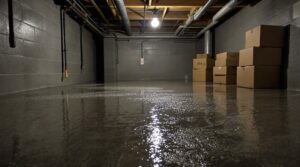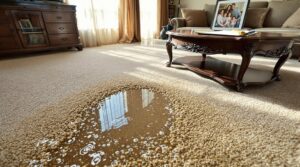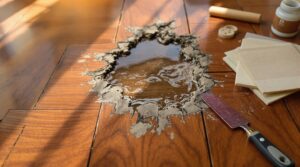Homeowners insurance covers carpet damage from specific perils, including water damage from burst pipes, fire, smoke, vandalism, theft, accidental spills, and falling objects. However, it excludes coverage for wear and tear, negligence, pet damage, gradual leaks, and earthquake-related damage without additional endorsements. Proper documentation and policy understanding are essential to claim approval. Engaging with policy details and potential endorsements can enhance comprehension and benefit claim processes.
Key Takeaways
- Homeowners insurance covers carpet damage from burst pipes, fire, smoke, vandalism, and falling objects.
- Standard policies exclude coverage for wear and tear, negligence, pet damage, and gradual deterioration.
- Accidental spills on carpets are typically covered under homeowners insurance.
- Coverage for carpet damage from natural disasters requires additional policy endorsements.
- Documenting the source and extent of carpet damage is crucial for a successful claim.
Understanding Covered Perils for Carpet Damage
When examining the scope of coverage for carpet damage under homeowners insurance, it is essential to identify the specific perils that are recognized as covered events. Homeowners insurance typically includes protection against water damage from burst pipes, fire and smoke damage, vandalism, theft, accidental spills, and damage from falling objects. It’s important to note that not all types of carpet damage are covered; for instance, damage due to general wear and tear or neglect is typically excluded from homeowners insurance policies. Homeowners should carefully review their policy to understand the extent of their homeowners insurance floor damage coverage, as this will help them know what to expect in the event of a claim. Additionally, some insurers may offer riders or endorsements that can broaden the scope of protection for specific types of damage, so exploring these options can be beneficial.
Understanding these perils allows policyholders to make informed carpet maintenance strategies, ensuring their carpets remain protected under various scenarios.
Insurance policy comparisons reveal that homeowners, renters, and condo insurance policies generally cover similar perils, although specific clauses may vary. For instance, standard policies incorporate coverage for accidental damage, emphasizing the importance of distinguishing between sudden events and gradual wear and tear.
While policyholders should be aware of the exclusions, knowledge of the covered perils enables strategic decisions regarding carpet care. Ultimately, leveraging insurance policy comparisons can aid in selecting the most thorough coverage for carpet protection.
Key Exclusions in Carpet Repair Coverage
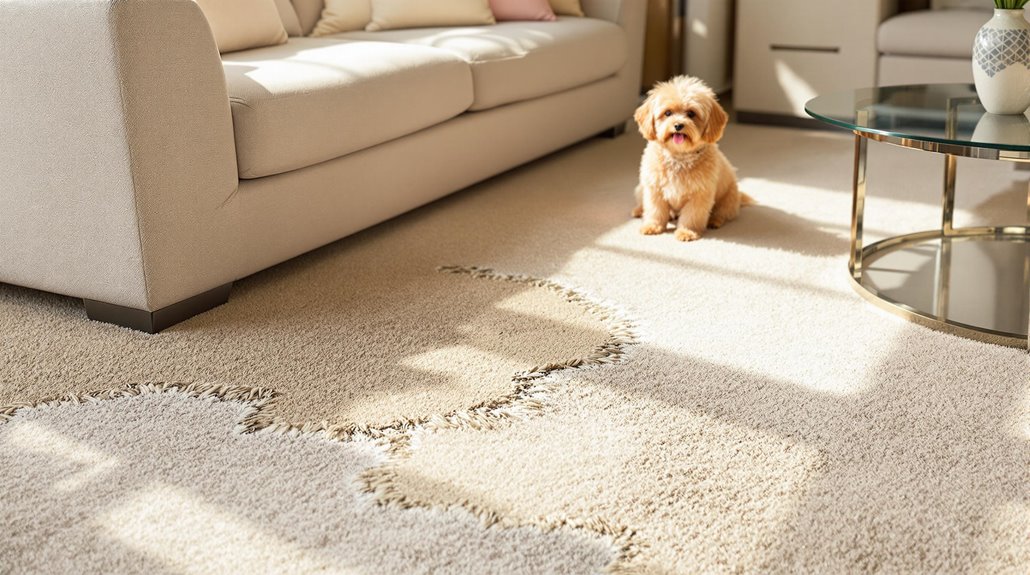
Although homeowner policies provide some protection for carpet damage, a thorough understanding of key exclusions is crucial for managing expectations regarding coverage.
Insurance exclusions commonly address wear and tear, homeowner negligence, and issues related to inadequate carpet maintenance. Damages resulting from gradual deterioration, such as slow leaks or infestations, are typically excluded. Additionally, pet-related damages and certain water ingress scenarios, like flooding from external sources, are not covered under standard policies.
Specific event exclusions include natural disasters such as earthquakes and landslides, and damage from drain and sewer backups requires additional endorsements. Mold growth, unless caused by a sudden event, falls outside the usual coverage scope.
Policies often limit coverage for high-value items, with deductibles applying before activation. Furthermore, the type of coverage—actual cash value versus replacement cost—affects compensation. Insurers exercise discretion, scrutinizing claims to verify damages were neither preventable nor due to insufficient maintenance.
Assessment Process for Carpet Damage Claims
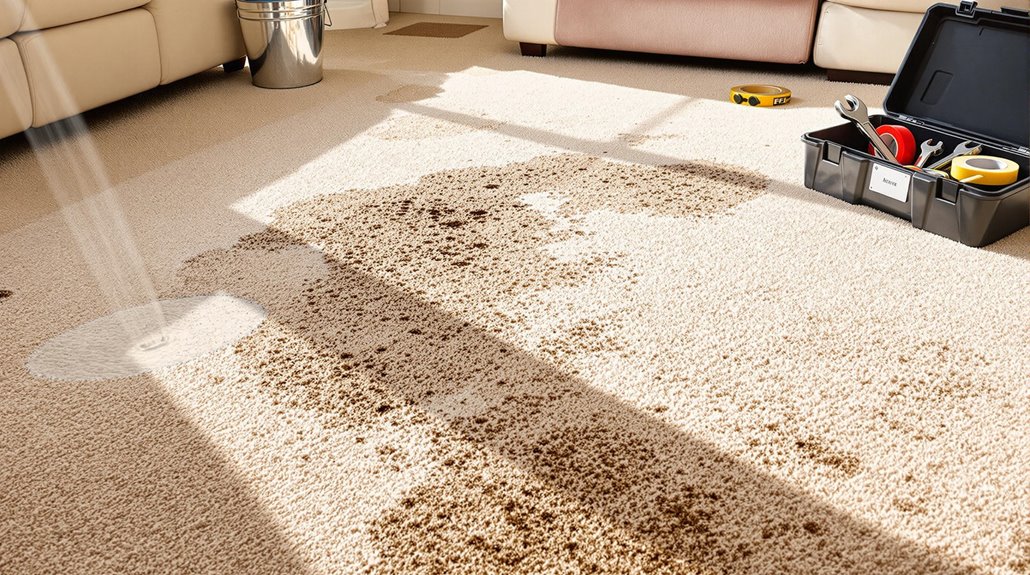
Understanding the exclusions of carpet damage coverage allows homeowners to better navigate the assessment process for claims. Initially, identifying and documenting the source of the leak is essential. This involves halting the water supply and capturing visual evidence, a step that aids in understanding insurance policy nuances related to liability.
Homeowners should preserve faulty parts for adjuster inspection to substantiate claims. Thorough documentation of damage through photos and videos is imperative, emphasizing affected areas and damage extent, including carpet restoration techniques that may be necessary.
Preparation for the insurance adjuster's visit demands making all areas accessible, ensuring the adjuster can accurately evaluate the damage. Presenting documented evidence will assist in clarifying the claim.
Following the inspection, detailed records of communications and a written repair estimate are crucial. These should encompass all repair costs, ensuring clarity in policy application. Retaining receipts for expenses related to carpet restoration supports the claims process effectively.
Evaluating the Extent of Damage and Compensation

How does one accurately evaluate the extent of carpet damage in the context of an insurance claim? Examining the damage involves meticulous documentation and evaluation practices.
Insurance adjusters rely on thorough evidence to determine compensation, taking into account factors such as carpet maintenance and damage prevention. Photographs and incident reports serve as primary documentation, while receipts and professional repair estimates establish the carpet's age and value.
The process also involves examining the cause of damage, ensuring it qualifies as a covered peril under the policy.
Key considerations in evaluating carpet damage include:
- Documentation: Photographic evidence, incident reports, and receipts.
- Policy Verification: Understanding coverage limits and exclusions.
- Professional Evaluation: Estimates from qualified repair professionals.
- Cause Analysis: Determining if the cause is a covered peril.
- Value Consideration: Evaluating age, value, and depreciation.
Compensation determination is influenced by the policy terms, including actual cash value, replacement cost value, and applicable deductibles.
Accidental and Sudden Events: What Qualifies?
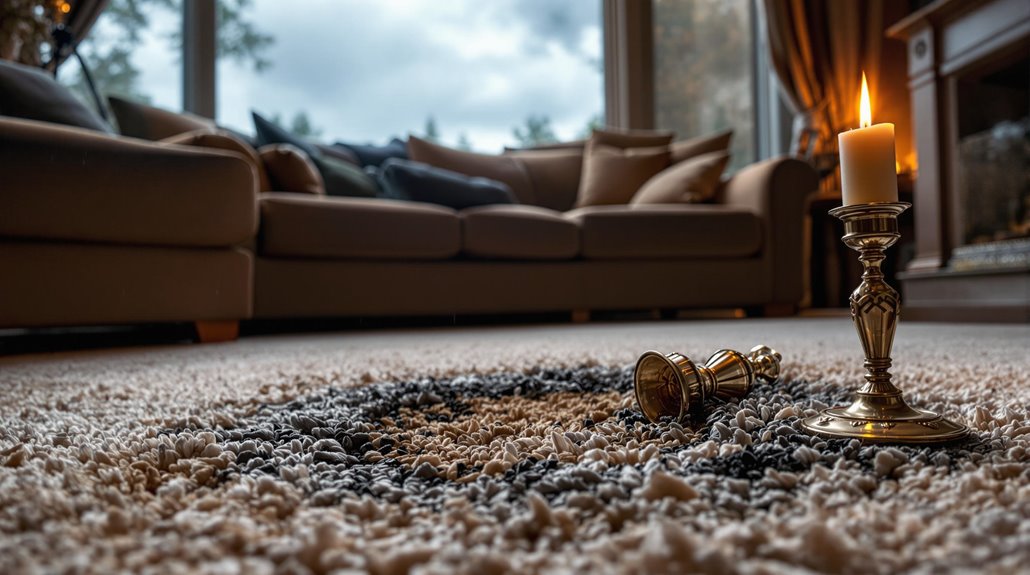
What qualifies as accidental and sudden events in the context of carpet damage under homeowners insurance policies? Insurers typically cover sudden incidents and accidental damage that are unforeseen and abrupt.
Covered perils often include fire damage, where carpets are affected by flames or smoke, and water damage from unexpected pipe bursts or plumbing failures. Vandalism and theft resulting in carpet damage are also generally within policy scope, alongside impacts from falling objects, like trees, and explosions.
Coverage hinges on the requirement that such events are both sudden and accidental, distinguishing them from gradual wear and tear, which remains uncovered.
Policies necessitate adherence to specific terms, such as timely notification to the insurer and furnishing adequate documentation. While accidental damage, including spills or burns, may be covered, it is subject to policy limits and exclusions, like pet damage or flooding, which typically require additional or separate insurance coverage.
Tips for Navigating the Claims Process

Why is thorough documentation essential for maneuvering the insurance claims process for carpet damage? Extensive claim documentation guarantees a robust foundation for the claims process, providing undeniable support for the claim's legitimacy.
The policyholder should meticulously compile evidence and engage in expert consultation when necessary. Such practices enhance the likelihood of a successful claim outcome.
- Photographic Evidence: Clear images of the carpet damage substantiate the claim and illustrate the extent of the issue.
- Incident Reports: Documentation from authorities or professionals can corroborate claims tied to specific incidents.
- Financial Records: Receipts and records for carpet purchases and previous maintenance help establish the carpet's value.
- Repair Estimates: Written assessments from qualified professionals offer a precise understanding of repair costs.
- Policy Familiarity: Understanding the terms and exclusions of the insurance policy prevents misunderstandings and guarantees alignment with coverage criteria.
Implementing these strategies facilitates a streamlined claims process, reducing the risk of claim denial.
The Benefits Of Consulting A Public Adjuster
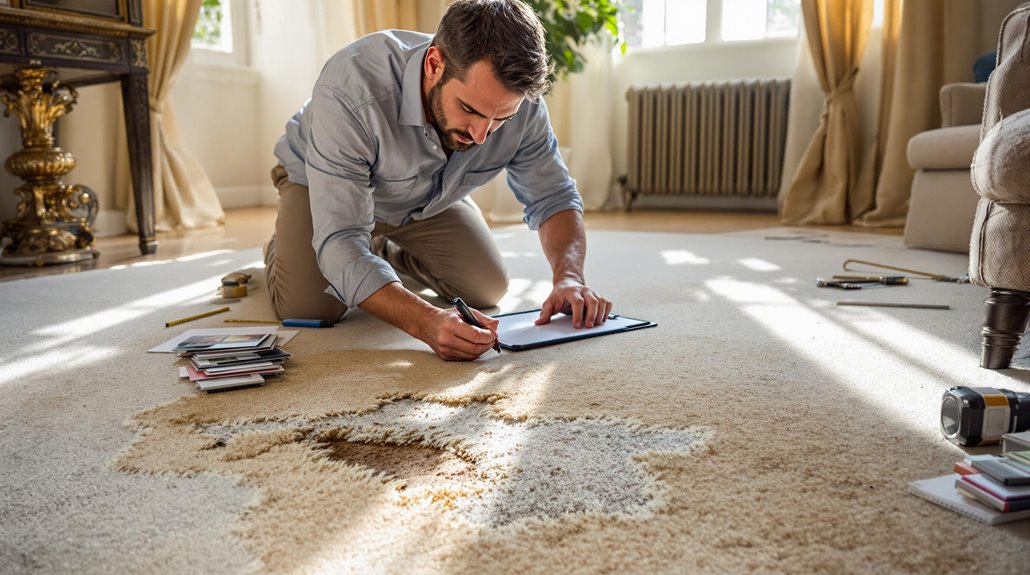
Consulting a public adjuster offers significant advantages in handling homeowners insurance claims related to carpet damage.
With specialized expertise in insurance claims, public adjusters provide an objective damage assessment that guarantees all aspects of the loss are accurately documented.
This professional guidance often results in a streamlined claims process and can lead to higher claim payouts and settlements for policyholders.
Expertise In Insurance Claims
Maneuvering the complexities of insurance claims requires specialized expertise, which is where the role of a public adjuster becomes invaluable. Their proficiency in claims terminology and policy interpretation guarantees that policyholders receive all entitled benefits.
Public adjusters possess an in-depth understanding of insurance policies and procedures, essential for steering through the often intricate claims process. They are adept at:
- Interpreting policy terms to maximize coverage
- Understanding coverage limits applicable to damages
- Recognizing and addressing common exclusions
- Gathering and organizing necessary claim documents
- Guaranteeing timely submission of paperwork
This expertise allows public adjusters to advocate effectively for policyholders, greatly reducing the stress and time associated with claims processing.
Their role is pivotal in achieving fair settlements and mitigating the complexities of insurance claims.
Objective Damage Assessment
A thorough damage assessment is essential for the accurate valuation of insurance claims, particularly when it involves complex assets such as carpets. Consulting a public adjuster offers numerous advantages, providing an objective evaluation that highlights the necessity of repair or replacement.
Carpet maintenance and damage prevention are key considerations during assessments, as they influence the overall claim outcome. Public adjusters provide an extensive review, documenting damages through detailed reports and visual evidence, which establish a solid foundation for negotiations with insurers.
Their expertise in policy terms and conditions guarantees that coverage limits and exclusions are meticulously analyzed. This independent evaluation aids in maximizing claim settlements, assuring that property owners receive equitable compensation for carpet damage, aligned with their homeowners insurance policy.
Streamlined Claim Process
Evaluating carpet damage objectively sets the stage for a streamlined claims process, highlighting the advantages of engaging a public adjuster.
Public adjusters notably enhance claim efficiency by expertly maneuvering the intricate insurance landscape. Their professional advocacy provides robust policyholder support, guaranteeing claims are handled with precision and expedience.
Engaging a public adjuster offers various benefits:
- Efficient Claim Handling: Guarantees accurate submissions and timely resolutions.
- Documentation Assistance: Facilitates extensive gathering and organization of necessary paperwork.
- Professional Communication: Manages insurer interactions, reducing policyholder stress.
- Claim Guidance: Guides through the complex claims process, guaranteeing compliance.
- Enhanced Accuracy: Conducts thorough assessments to prevent errors and maximize claim potential.
Higher Claim Payouts & Settlements
Consulting a public adjuster can lead to considerably higher claim payouts and settlements for homeowners dealing with carpet damage.
These professionals leverage expert knowledge of insurance policies and claim strategies to identify all potential damages and guarantee thorough documentation. Their detailed evidence collection often results in higher claim amounts.
Equipped with advanced negotiation tactics, public adjusters effectively engage with insurance companies to secure ideal settlements, maximizing policyholder benefits. By advocating for full utilization of applicable coverage, they confirm policy terms are fully leveraged.
Although there are costs associated with hiring a public adjuster, their ability to increase claim payouts typically offsets these expenses, providing a net financial advantage.
Their role also includes interpreting policy language to favor the homeowner, reducing the burden on the insured.
About The Public Claims Adjusters Network (PCAN)
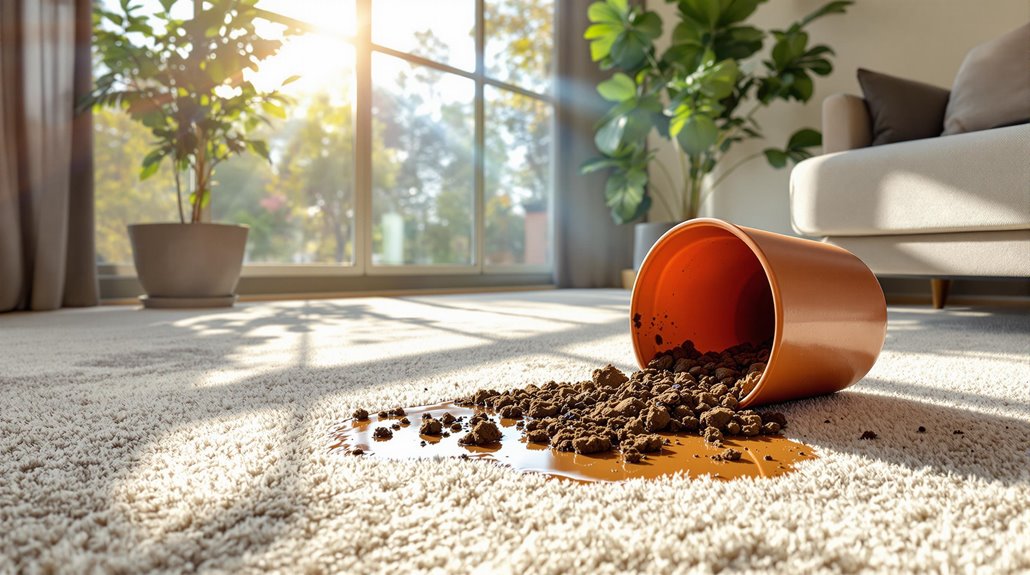
With a formidable reputation in the domain of insurance claims, the Public Claims Adjusters Network (PCAN) offers an extensive suite of services designed to guarantee policyholders receive equitable settlements.
Leveraging an expansive network of licensed public adjusters, PCAN specializes in public adjuster roles and claims negotiation strategies. This enables them to navigate complex insurance claims processes effectively, encompassing both residential and commercial properties.
PCAN operates in multiple states and countries, providing thorough support from the initial notice to the final settlement.
Their services are meticulously structured to:
- Advocate for policyholders to ensure fair compensation.
- Analyze and interpret intricate insurance policies.
- Validate the legality of insurer-presented claims.
- Calculate precise repair and construction costs.
- Facilitate seamless communication with insurers and contractors.
The network's commitment to professionalism enhances efficiency and responsiveness in claims handling, ensuring ideal outcomes for policyholders and customizing solutions to address unique challenges throughout the claims lifecycle.
Frequently Asked Questions
How Does Carpet Age Affect Insurance Compensation?
Carpet age considerably impacts insurance compensation through depreciation factors, as older carpets experience greater value reduction. Insurers assess carpet lifespan, original cost, and depreciation to determine payout, emphasizing the importance of thorough documentation to guarantee fair compensation.
Do Insurance Policies Cover Carpet Stains From Pet Accidents?
One might whimsically hope pet insurance extends to carpet replacement after a pet's creative endeavor, yet standard homeowners insurance humorously abstains from such generosity. Policies typically exclude pet stains, viewing them as maintenance, not a covered peril.
Is Mold Damage to Carpets Covered by Homeowner's Insurance?
Insurance claims for mold cleanup in carpets depend on the cause. Coverage typically applies when mold results from sudden, accidental events or covered perils. Policy specifics and maintenance levels greatly influence whether the insurance will cover mold damage.
Can Policyholders Choose Their Own Carpet Repair Professionals?
Can policyholders choose their own carpet repair professionals? Like a captain steering a ship through insurance waters, policyholder rights allow choice within policy confines. Adherence to guidelines guarantees selection of competent repair professionals, safeguarding claims and fostering successful resolutions.
Does Insurance Cover Carpet Damage From Construction Accidents?
Insurance liability may cover carpet damage resulting from construction negligence if deemed a covered peril under the policy terms. Policyholders must provide documentation and demonstrate the accident's sudden and accidental nature to guarantee eligibility for coverage.



